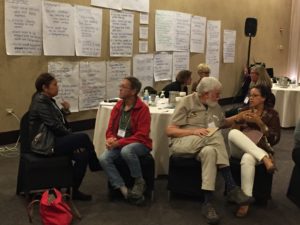Friedrichs Redux

The third in a series. See Time to Double Down and 4 Things Public Sector Unions Are Doing
Among the many uncertainties there are about the new administration, there is one thing we can predict with confidence: Friedrichs redux.
Public sector union leaders breathed a sigh of relief when Friedrichs vs. California Teachers Association was blocked by a 4-4 tie last spring. There were plenty of other priorities – like state budgets, pension attacks, and strike deadlines– that quickly took precedence. Now that Trump is in position to nominate the 9th Justice to the Supreme Court, we can expect a new case to make its way to their docket in about a year.
The clock is ticking again, and it is back to basics. We learned last time that there were four main areas of focus in getting ready: employee data, steward structures, member engagement & new hire recruitment. As those core functions get solidified, unions do better – but is it enough?
An attack on the middle class and poor
State and local governments can be bureaucratic and slow-moving, but they have also become places of upheaval and cutbacks. Public sector unions have become a critical line of defense to protect middle class jobs and paths out of poverty.
An insidious part of the right-wing attack has been to blame public employees for being self-interested and poor people for being poor. Teachers, bus drivers, and garbage collectors are made to feel greedy and undeserving. The unemployed, sick and disenfranchised are made to feel inferior. Unions who have reframed that narrative – like the Chicago Teachers Union – have done so by allying themselves more closely with the communities they serve, and going on the offense.
While people want to see their union fighting and winning, they don’t want to be in a constant state of conflict at work. Issues get settled, contracts get ratified. So the challenge when union members can withdraw their support any day of the year is how unions can show their value at all stages of war and peace.
Innovation: buzzword or necessity? 
If you do X, then Y will happen. In this formula, planned activity leads to predictable results. Better planning leads to better results. But what do you do if you don’t know Y? Or you aren’t sure about X? This is the kind of complex and volatile environment we find ourselves in as 2017 begins.
Lean, agile and scrum may sound like tech sector buzzwords but these and other innovation strategies are now being applied to challenges of all sorts. From app development and web-based services to public health and even happiness – the innovation approach is moving into the mainstream.
Most of what unions do remains in the plan-do cycle, but for unions facing Friedrichs redux, another cycle is also needed: discover-test-learn-build. It starts by stripping away assumptions and finding out what we don’t know develop new hypotheses about what might work. Those ideas are tested in short cycles and we learn from both failure and success. The ideas that have potential are built up and scaled.
What are the areas that most cry out for an innovation approach? No surprise, it’s employee data, steward structures, member engagement, and recruiting new hires. But there are also needs in the areas like public messaging, member programming, community partnerships and under 35 members.
In 2017, necessity is the mother of innovation.

Next: who’s already innovating and what are they learning?
Comments
Leave a Reply
